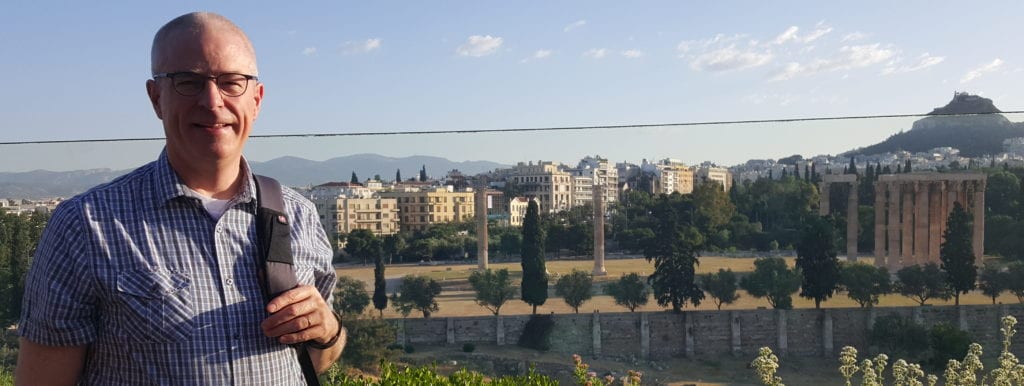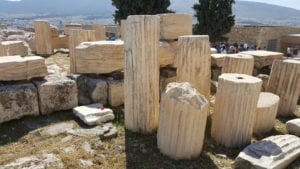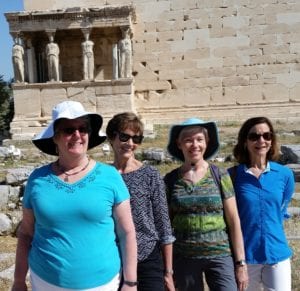
Breakfast at the Royal Olympic Hotel
At 5:22 a.m., after a few hours lying sleepless in a darkened room at the Royal Olympic Hotel, Nancy finally turned to Michael and muttered, “Are you ready to just give up and get up?” He was, so neither of us had to hurry to shower, dress, and repack before going to breakfast. An extensive buffet was spread out in the seventh-floor dining room, whose open-air balcony overlooks the ruins of the Temple of Zeus across the street. The Acropolis graces the view a mile or so to the west.

Overlooking the Temple of Zeus

Historical Museum of Athens

Athenian Academy and Library

1896 Olympic Stadium

Odeon, a Roman amphitheater
By 8:00 a.m., everyone in the Gee Group had brought their luggage to the lobby and boarded a bus waiting just outside the entrance, and soon we were wending our way through the streets of Athens. Today’s guide, Niki, provided historical details as she pointed out places of interest passing by on our right and left, including the Athenian Academy and Library, whose glittering white marble columns and gilt statuary were nearly blinding in the morning sunshine. We made a brief stop at the stadium built in 1896 for the first modern Olympic Games. The venue, which seats 69,000 spectators, was also used for the finish of the marathon and a few other events during the 1996 Olympics. About 9:30, the bus parked at the base of the Acropolis and we—along with hundreds of other tourists and a few busloads of noisy Greek schoolchildren—began making our way toward the top.

Parthenon
Despite having carefully studied the architecture of the ancient monuments on Athens’s famous hilltop in Humanities 201 back in 1973 (and having taught the same details to the next wave of students five years later), neither Michael nor Nancy was quite prepared for the way the Acropolis stands above and apart from the city around it.

Steep climb to the to Temple of Athena Nike

Slippery, well-worn stones
The roughly oval, granite outcrop rises more than a hundred meters above ground level on every side, so the light golden marble structures on top are visible from all over the city. One does not approach the Temple of Athena up a gradual incline from the Agora the way we had pictured the scene; instead, visitors mount a steep staircase and then, as on the Areopagus, must pay close attention to their footing to avoid slipping on uncut, bumpy stone worn smooth as ice over the centuries.

The Parthenon’s huge columns are composed of several marble cylinders, carefully cut and stacked to look like a solid shaft of stone. Originally, the cylinders were held together with lead rods that ran down the center of each column, but the Ottoman soldiers who occupied Athens for three hundred years disassembled many of the columns and melted down the lead inside to make musketballs.

Column of stacked cylinders

Montgomery quartet mimics Caryatids at the Erechtheum
None of the monuments on the Acropolis have survived anywhere near intact; the hilltop is strewn with chunks of marble that once constituted fluted columns, decorative moldings, and other architectural elements. Sometime in the distant past, the statue of Athena Nike, which had been sculpted without the traditional wings of victory specifically so she wouldn’t be able to fly away, was carried off by unknown raiders. Nearly all of the other original statuary and friezes also were looted long ago by conquerors who styled themselves heroes. Yesterday, our guide had pointed out a bust of actress Melina Mercouri that honors her genuinely heroic but still unsuccessful effort to persuade the British to return the bas-relief friezes Lord Elgin pried from the Parthenon in 1801. Rows of numbered stone fragments attest that the tasks of conserving the site and restoring the monuments continues—slowly. It can’t be easy trying to work around millions of visitors, all of whom feel entitled to take selfies with these precious remnants of our shared cultural heritage.

Our Athenian tour bus

Church of St. Nikolaos in Piraeus. In Greece, St. Nikolaos does not bring gifts at Christmastime. He is the patron saint of sailors and fishermen.
We wish we had had at least another couple of hours in Athens—especially after Cathy and Jeff described some of the artifacts they had been able to see in the Museum of the Acropolis last night—but we had an appointment at noon with the Wind Star. Nobody wanted to miss the boat, so we all got back on the bus and headed for the port at Piraeus, about nine miles from the center of Athens. On the way, Niki explained that although Piraeus has been a port city since ancient times, most of the buildings there date from the mid-twentieth century; older structures were pretty much destroyed by bombs during World War II.

The port of Piraeus
When we arrived at the cruise ship terminal, we were informed that we would not be able to board for another hour because a different ship was still in the berth designated for the Wind Star. Although we were annoyed that we might have spent another hour exploring Athens, we passed the time by getting better acquainted with our Discovery XA traveling companions. Nancy enjoyed hearing Amanda tell about how her late husband, a high school science teacher, had completely changed the life of the Russian exchange student he invited to live with them after she had been rejected by three other local families. (An adamant atheist, the girl was in danger of being sent back to Russia because her outspoken derision of anyone who believed in God had offended nearly everyone in the largely LDS town. After enduring the girl’s tirades with more patience than most, Amanda’s husband finally suggested that if she believed in an evil force—and she had stated that she absolutely did—then why couldn’t she believe in the existence of a similar force for good? “That’s God,” he explained. The thought transformed the girl’s entire attitude and demeanor—for the rest of the year, at least. Amanda still wonders what became of her after she returned to Russia.)
Meanwhile, Carol gave each couple a packet containing our boarding cards and stateroom assignments. When it was time to begin boarding, the Wind Star’s welcoming crew offered cold drinks and cookies to those in the queue; our Polish captain and Bahamian hotel manager greeted us at the top of the gangplank. After refreshing our hands and faces with cool, moist cloths from a silver basin in the lobby and depositing our passports at the check-in table, we proceeded to Veranda, the Wind Star’s “casual” restaurant, where our lunch was waiting. The buffet included a salad bar with a typical assortment of greens and toppings plus a number of composed salads such as curried chicken, and potatoes dressed with a vinaigrette. In addition, there was a selection of hot dishes, including an irresistible roasted beef filet. The accompanying bread and rolls were especially good. Because the weather was so pleasant, most of us took our plates outside to shaded tables on the lower deck.

Michael at the desk in our stateroom

Nancy testing the bed in our stateroom
After lunch, everyone retired to their staterooms to unpack. (Why the private cabins on ships are called staterooms remains an unexplained curiosity.) Saka, our Indonesian steward, came by to introduce himself and assure us that he would do whatever he could to make us comfortable. That goal didn’t seem too hard to achieve because our cabin (111, on the starboard side) was tastefully appointed, very clean, and more commodious than we had expected. Every inch of available space had been converted into convenient storage compartments—so many that we couldn’t even fill them. In one, we found two life jackets. Soon we heard a general announcement requesting that all passengers bring their life jackets and report to their assigned “muster stations” at 4:15 for a safety drill. Carol had assured us that the Aegean was well protected within its ring of islands and therefore was generally calm, but, remembering Paul’s account in Acts 27 of a nasty shipwreck, we thought it best to pay more attention to the ship’s emergency procedures than we usually do to the airlines’.

The captain’s bridge

Budge, Linda, Lynn and Mark relaxing on deck
When the safety drill was over and we had stowed our life jackets back in their cubbies, the twenty-four members of the Gee Group gathered in the lounge so that Jim could review our schedule for tomorrow. We also took some time for individual introductions. One of the Cincinnati contingent later joked that it might have been more interesting had we allowed someone else to introduce us instead of speaking for ourselves, but it was fun to hear what each of our long-time friends thought new acquaintances should know about them.

Amanda, Eva, Cathy, Jeff and Barry enjoying the view from the deck
Besides the six Cincinnati couples and Jeff and Cathy, the Gee Group includes the ever-amazing Amanda, her daughters Joyce and Patti, and Patti’s husband Jeff, all of whom are from the west side of the Great Salt Lake, near the salt flats. The other two couples also are from Utah: Steve and Jan are from Farmington, and Barry and Eva (pronounced with a short e, “as in forevah and evah,” she explained) are from Highland.
Everyone wanted to be on deck at 5:30 p.m. for the hoisting of the sails as the Wind Star glided away from Piraeus. The moment wasn’t as dramatic as we had hoped because only one of the sails was unfurled, but heading out to sea on a luxury yacht for the first time was pretty amazing nevertheless. After enjoying drinks and the wind in our hair for a while, we went back to our rooms to choose something “casual, yet elegant” to wear for the evening.

Nancy, Lynn, Mark, Jeff, Cathy, Judith and Richard

Sole roulade

Meringue and berry mousse
The Gee Group had agreed to meet in the AmphorA dining room at 7:00. Michael and Nancy were seated with Jeff, Cathy, Mark, Lynn, Richard, and Judith at a table near the middle of the room. The steward assigned to our table, another Indonesian named Yusuf, introduced himself with a flourish and announced that we were now a part of “Yusuf Kingdom” and thus could expect “rrrroyal treatment.” (Yusuf continued to extravagantly rrrroll his rs all evening.) For the first course, Michael chose the mushroom pastry, while Nancy had a salad composed of baby greens and caramelized apple and onion slices. Both also indulged in more fresh rolls with butter than we should have. For our main plate, both of us chose the seafood special: mango-stuffed sole roulade, served on a bed of cranberry rice pilaf and courgettes. For dessert, Michael had a crisp meringue filled with berry-flavored mousse; Nancy had a moist, buttery bread pudding topped with a crunchy crumb crust. If every meal is like this one, we may not be able to zip up our pants by the end of the week.
Much of the conversation at our table tonight centered around Cathy’s work as a psychotherapist and the experiences she and Jeff have had integrating two adopted daughters with troubled pasts into their already large family. We admire the patience and faith with which they have helped all of their children prepare for the challenges of adulthood.
Despite the engrossing discussion, by 9:00 all of us were eager to get some sleep. Fortunately, the sea has been fairly calm, so none of us felt any first-night nausea. It was very soothing to look out our portholes after we turned off the lights and watch moonbeams reflect off each gentle swell.
Leave A Comment